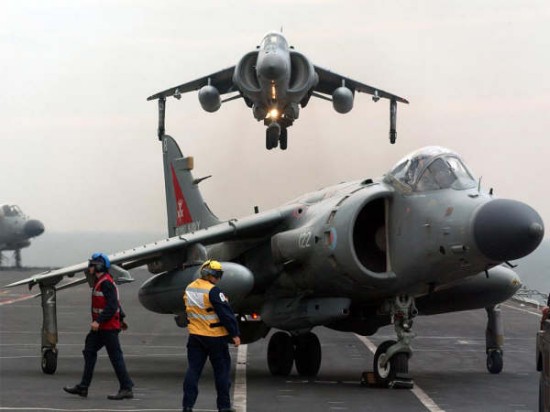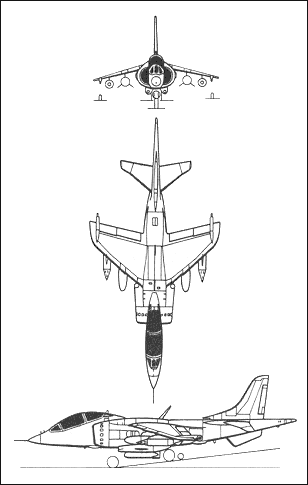|
||||||||||
|
|
||||||||||
|
||||||||||
|
|
||||||||||
 - -
|
|

|
British Aerospace Harrier & Sea Harrier Attack Fighters |
|
DESCRIPTION:
Development of the revolutionary Harrier "jump-jet" began in the early 1960s. It was during this time when British planners began recognizing the benefits a vertical takeoff aircraft could have in reducing dependence on vulnerable runways and large, expensive aircraft carriers. Work on the Royal Air Force's Harrier GR.1, tailored for attack and reconnaissance roles, commenced in 1965. At the heart of the Harrier's vertical takeoff and landing capability was the Rolls-Royce Pegasus turbofan engine and a series of four vectored-thrust nozzles able to pivot through 110 degrees. Also utilizing a number of small reaction control jets, the Harrier demonstrated exceptional stability in hover and superb maneuverability in flight. Though the Harrier's potential for use at sea was known by the time the RAF's GR.1 and GR.3 entered service, the Navy program suffered many delays due to political bickering. It was not until 1975 that the Sea Harrier project was finally approved. The two models were largely identical except that the Royal Navy Sea Harrier FRS.1 had a different nose enclosing a new radar. The Sea Harrier's cockpit was also raised higher to improve pilot visibility. Both types quickly proved their value during the Falkland Islands conflict with Argentina. The Air Force's GR.3 was used for ground attack while the Navy's FRS.1 provided air defense. Thanks to their maneuverability as well as better weapons and training, the Harriers performed well against their Argentinian adversaries. The Sea Harriers compiled a record of 21 kills versus no air-to-air losses, but two were shot down by ground fire and another four were lost to accidents. Four GR.3 planes were also lost for similar reasons. Despite their successes, the Harriers were never able to gain complete air superiority leaving the British fleet vulnerable to attack. Five Royal Navy ships were sunk by bombs or missiles launched by Mirage, Super Etendard, and Skyhawk aircraft. The Harriers also failed to disable the main airbase at Port Stanley which continued to pose a threat to British plans throughout the war. The RAF's GR.1 and GR.3 were gradually retired, but the Royal Navy built on the Falklands experience with the improved Sea Harrier FA2 optimized for fighter/attack missions. This version introduced a better radar, new cockpit displays, and increased air-to-air weapon carriage for enhanced air superiority capability. The FA2 was also the first UK plane able to carry the American AMRAAM missile. This upgraded Sea Harrier model saw additional action in the Balkans before being removed from service in 2006. Many were surprised by the retirement since much of the fleet remained relatively young and F-35 replacements were not due to arrive until at least 2012. Nevertheless, the FA2 had become costly to maintain and was retired to focus resources on the more modern Harrier II. Beyond the UK, the original Harrier also became an export success. This was due largely to the US Marine Corps buying a version of the GR.1/GR.3 called the AV-8A and India's purchase of an FRS.1 derivative. Though the Marine fleet was retired long ago in favor of the AV-8B, India continues to upgrade its Sea Harrier force for use on its aircraft carriers until the navalized Tejas becomes available. Spain also bought a version of the AV-8A for its navy, and these are now sporadically operated by Thailand on its lone aircraft carrier. British Aerospace long tried to interest the British government in an improved Harrier with better aerodynamics and greater payload. Though the UK originally showed little interest, BAe eventually teamed with McDonnell Douglas in America to build the Harrier II.
Data below for Harrier GR.3 and Sea Harrier F/A.2 where indicated |
|
| HISTORY: | |
| First Flight |
(GR.1) 28 December 1967 (AV-8A) August 1970 (FRS.1) 20 August 1978 (F/A.2) 19 September 1988 |
| Service Entry |
(GR.1) April 1969 (FRS.1) April 1980 |
|
Retirement
|
(F/A.2) March 2006
|
|
CREW:
|
one: pilot
|
|
ESTIMATED COST:
|
unknown
|
| AIRFOIL SECTIONS: | |
| Wing Root | unknown |
| Wing Tip |
unknown
|
| DIMENSIONS: | |
| Length |
(GR.3) 47.17 ft (14.37 m) (F/A.2) 46.50 ft (14.17 m) |
| Wingspan | 25.25 ft (7.60 m) |
| Height |
(GR.3) 11.25 ft (3.42 m) (F/A.2) 12.17 ft (3.71 m) |
| Wing Area | 201.1 ft² (18.68 m²) |
|
Canard Area
|
not applicable
|
| WEIGHTS: | |
| Empty |
(GR.3) 12,200 lb (5,533 kg) (F/A.2) 14,052 lb (6,374 kg) |
| Normal Takeoff | unknown |
| Max Takeoff |
(GR.3) 26,000 lb (11,793 kg) [short-takeoff] (F/A.2) 26,200 lb (11,884 kg) |
| Fuel Capacity |
internal: 5,060 lb (2,295 kg) external: 5,300 lb (2,404 kg) |
|
Max Payload
|
8,000 lb (3,630 kg) [short takeoff] 5,005 lb (2,270 kg) [vertical takeoff] |
| PROPULSION: | |
| Powerplant | one Rolls-Royce Pegasus Mk 106 vectored-thrust turbofan |
| Thrust |
21,500 lb (95.64 kN)
|
| PERFORMANCE: | |
| Max Level Speed |
at altitude: Mach 1.25 at sea level: 735 mph (1,185 km/h), Mach 0.97 sea level cruise: 405-520 mph (650-835 km/h) |
| Initial Climb Rate | 50,000 ft (15,240 m) / min |
| Service Ceiling | 51,000 ft (15,545 m) |
| Range |
typical: 540 nm (1,000 km) ferry: 1,800 nm (3,330 km) |
| g-Limits |
+7.8 / -4.2
|
| ARMAMENT: | |
| Gun | two 30-mm Aden gun pods (150 rds ea) |
| Stations | five to seven external hardpoints |
| Air-to-Air Missile | AIM-9 Sidewinder, AIM-120 AMRAAM, Sky Flash, Matra 550 Magic |
| Air-to-Surface Missile | Wasp, Sea Eagle, AGM-84 Harpoon |
| Bomb | WE177 nuclear, GBU-13/-18 Paveway laser-guided, 1,000-lb GP, BL.755 cluster, Matra 400-kg retarded bombs |
| Other |
rocket pods, ECM pods, recon camera pods, munition dispensers
|
| KNOWN VARIANTS: | |
| GR.1 | Production attack fighter for the RAF with a Pegasus Mk 101 engine; 118 built (including GR.1A and GR.3) |
| GR.1A | Upgrade based on the GR.1 with a more powerful Pegasus Mk 102 engine; 41 modified and 17 built |
| T.2 | Two-seat trainer for the RAF |
| T.2A | Two-seat trainer incorporating the upgrades of the GR.1A |
| GR.3 | Improved GR.1 with a Pegasus Mk 103 engine and more capable sensors such as a laser tracker |
| T.4 | Two-seat trainer |
| T.4N | Two-seat trainer for the Royal Navy |
| Mk 52 | Two-seat demonstrator used by British Aerospace; 1 built |
| AV-8A (Mk 50) | US version similar to the GR.1 but incorporating some improvements of the GR.3, purchased by the Marines and operated from amphibious assault ships; 102 built |
| TAV-8A (Mk 54) | Two-seat trainer version of the AV-8A; 8 built |
| AV-8C | Upgraded AV-8A with a strengthened airframe and updated communications equipment; 47 converted |
|
AV-8S Matador (Mk 53/55) |
Variant of the American AV-8A originally built for the Spanish Navy and later resold to Thailand |
| VA-1 Matador | Spanish designation for the AV-8S |
| TAV-8S (Mk 54) | Two-seat trainer version of the AV-8S, also resold to Thailand |
| VAE-1 Matador | Spanish designation for the TAV-8S |
| AV-8B/GR.5/7/9 | Improved models of the original Harrier known as the Harrier II |
| FRS.1 | First production carrier-based Fighter/Reconnaissance/Strike model for the Royal Navy and based on the GR.3, 29 flew 2,376 sorties during the Falklands War shooting down 21 Argentine aircraft; 57 built for the UK |
| FRS.51 | Version of the FRS.1 purchased by the Indian Navy; 23 built |
| T.60 | Two-seat trainer for India based on the T.4N; 4 built |
| F/A.2 (FA2) | Improved attack fighter for the Royal Navy with an improved radar, new cockpit displays, and increased payload; 18 built and 5 modified from FRS.1 |
| T.8 |
T.4 trainers upgraded with FA2 instrumentation
|
| KNOWN COMBAT RECORD: |
Falklands War (RAF, RN, 1982) Bosnia - Operation Deliberate Force (RN, 1995) Kosovo - Operation Allied Force (RN, 1999) |
| KNOWN OPERATORS: |
India (Indian Naval Air Squadron) Spain, Arma Aérea de la Armada Española (Spanish Naval Aviation) Thailand, Kong Tha Han Lur Thai (Royal Thai Navy Air Arm) United Kingdom (Royal Air Force) United Kingdom (Royal Navy) United States (US Marine Corps) |
|
3-VIEW SCHEMATIC:

|
|
SOURCES:
|
|


|
Aircraft | Design | Ask Us | Shop | Search |

|
|
| About Us | Contact Us | Copyright © 1997-2023 | |||
|
|
|||